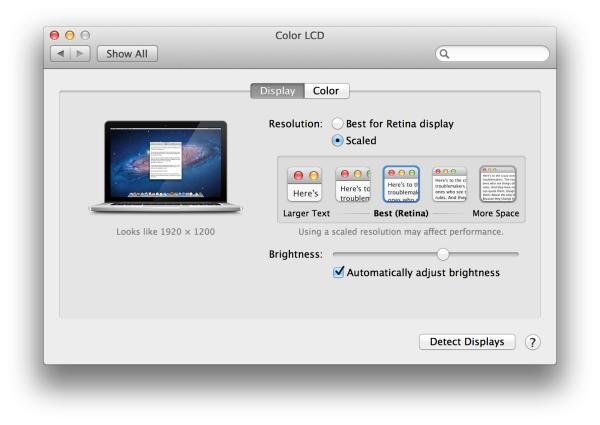How the Retina Display MacBook Pro Handles Scaling
by Anand Lal Shimpi on June 11, 2012 7:36 PM EST- Posted in
- Mac
- Apple
- MacBook Pro
- Laptops
- Notebooks
Earlier this morning Apple introduced its next-generation MacBook Pro equipped with a Retina Display. The 15.4-inch panel features a native resolution of 2880 x 1800, or exactly four times the standard 1440 x 900 resolution of a regular 15-inch MacBook Pro. As we've seen in the past however, an ultra high resolution screen in a small form factor can make for some very difficult to read text. The Retina MBP ships with a version of OS X Lion however that supports a number of scaling modes to take advantage of the ultra high res display.
By default, the Retina MBP ships in a pixel doubled configuration. You get the effective desktop resolution of the standard 15-inch MacBook Pro's 1440 x 900 panel, but with four physical pixels driving every single pixel represented on the screen. This configuration is the best looking, but you don't actually get any more desktop space. Thankfully Apple exposes a handful of predefined scaling options if you do want additional desktop space:
Apple offers five scaled settings including the default pixel doubled option: 1024 x 640, 1280 x 800, 1440 x 900, 1680 x 1050 and 1920 x 1200. Selecting any of these options gives you the effective desktop resolution of the setting, but Apple actually renders the screen at a higher resolution and scales it to fit the 2880 x 1800 panel. As a result of the upscaled rendering, there can be a performance and quality impact. It's also worth noting there's no default option for 2880 x 1800, which is understandable given just how tiny text would be at that resolution. I suspect it won't be long before users figure out how to manually add a zero-scale, 2880 x 1800 option.
The gallery below shows the impact of these scaling options on desktop area as well as how much of the AnandTech front page you can see at each setting.
















74 Comments
View All Comments
Daniel Egger - Wednesday, June 13, 2012 - link
10.7.4 changed the font rendering algorithm quite noticeably (at least for me it is a huge step backwards -- no idea why no one else hasn't complained). On my 17" MBP (Early 2011) with Anti-Glare Display it is quite easy to see that the text is rendered using much more grey around the glyphs thus reducing contrast thus making text much less crisp and harder to read. The negative impact was so apparent when I booted up after the update that I seriously thought about getting my eyes checked that moment...Reminds me of the first (non-subpixel) antialiasing tries without proper font hinting on Linux 10 years ago. Horrible...
I hope they'll find a way to fix this for non-Retina users...
tipoo - Friday, June 15, 2012 - link
I'm a bit confused about how it scales, so elements on screen *look* like they are at a lower resolution, but during the presentation they showed a 1080p movie playing using a fraction of the screen space, if everything displays like it would at a lower res that would not be possible. So what were they talking about there, how would a non-scaled 1080p video play?luizhdcosta - Saturday, June 23, 2012 - link
I got a MBP 2011 and a 24 inches 1080 monitor. I was wondering if i could run it in a 1440x900 or a 1280x720 resolution in a scaled mode like the new MBP retina does with higher resolutions.What I mean is not only setting the resolution to 1440x900 or 1280x720, but make it be in this proportion but send 1920x1080 to my monitor, like the other scaling options on the retina MBP.
platinumjsi - Thursday, January 16, 2014 - link
Can someone explain to me why the OS cant output at the native res and just increase the text / app size?